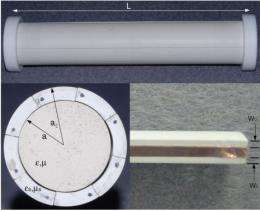August 11, 2011 report
Researchers create first 3D invisibility cloak

(PhysOrg.com) -- Science has taken one more step towards creating a true real-life cloaking device. Assistant Professor Andrea Alůin and his colleagues at the University of Texas at Austin have successfully created a cloaking device capable of "hiding" a 3D object in free space from microwaves. The team describes how they used a "plasmonic" shell to hide a cigar shaped object from one microwave polarization in their pre-printed paper on arXiv.
Cloaking devices are based on so-called metamaterials and follow up on the pioneering efforts of David Smith and his team at Duke University in North Carolina, who in 2006 first discovered it was possible through the use of metamaterials, to deflect microwave radiation around an object, thus rendering it, virtually invisible. Subsequent work by other research teams have led to 2D or 3D carpet cloaking devices that are able to cloak an object pressed against a plane. With this new research, Alůin and his team claim to have created a cloaking device able to hide an object in free space.
To create the device, the team used a plasmonic shell to cover the object being cloaked. Plasmonic materials (normally used when making solar cells) are able to bend electromagnetic radiation in unique ways, and in this case, cancel the light scattered by the object. The shell works because it is has a polarization opposite to the scattered light and thus cancels it out, effectively cloaking the object hidden within. The object in this case was a hollow dielectric (an electrical insulator that can be polarized) cylinder. The shell was comprised of the same material though it was constructed from segments separated by precision cut copper tape and held together by end-caps. The resultant cloaking device was able to suppress scattering all around the object and from more than one angle.
In the paper Alůin suggests that he knows of a way to create a similar cloaking device that would work with un-polarized light, which would allow more than just one frequency of microwaves to be used, but in this case went with just one for simplicity’s sake. He also says simulations show that the same technique should work for other bandwidths, presumably infrared and optical wavelengths.
More information: Experimental 3D Plasmonic Cloaking in Free Space, David Rainwater, Aaron Kerkhoff, Kevin Melin, Andrea Alu, arXiv:1107.3740v1 [cond-mat.mtrl-sci] arxiv.org/abs/1107.3740
Abstract
We report the first experimental verification of a metamaterial cloak for a 3D object in free space. We apply the plasmonic cloaking technique, based on scattering cancellation, to suppress microwave scattering from a finite dielectric cylinder. We verify that scattering suppression is obtained all around the object and for different incidence angles, validating our measurements with analytical results and full-wave simulations. Our experiment confirms that realistic and robust plasmonic metamaterial cloaks may be realized for elongated 3D objects at microwave frequencies.
via PhysicsWorld
© 2011 PhysOrg.com

















